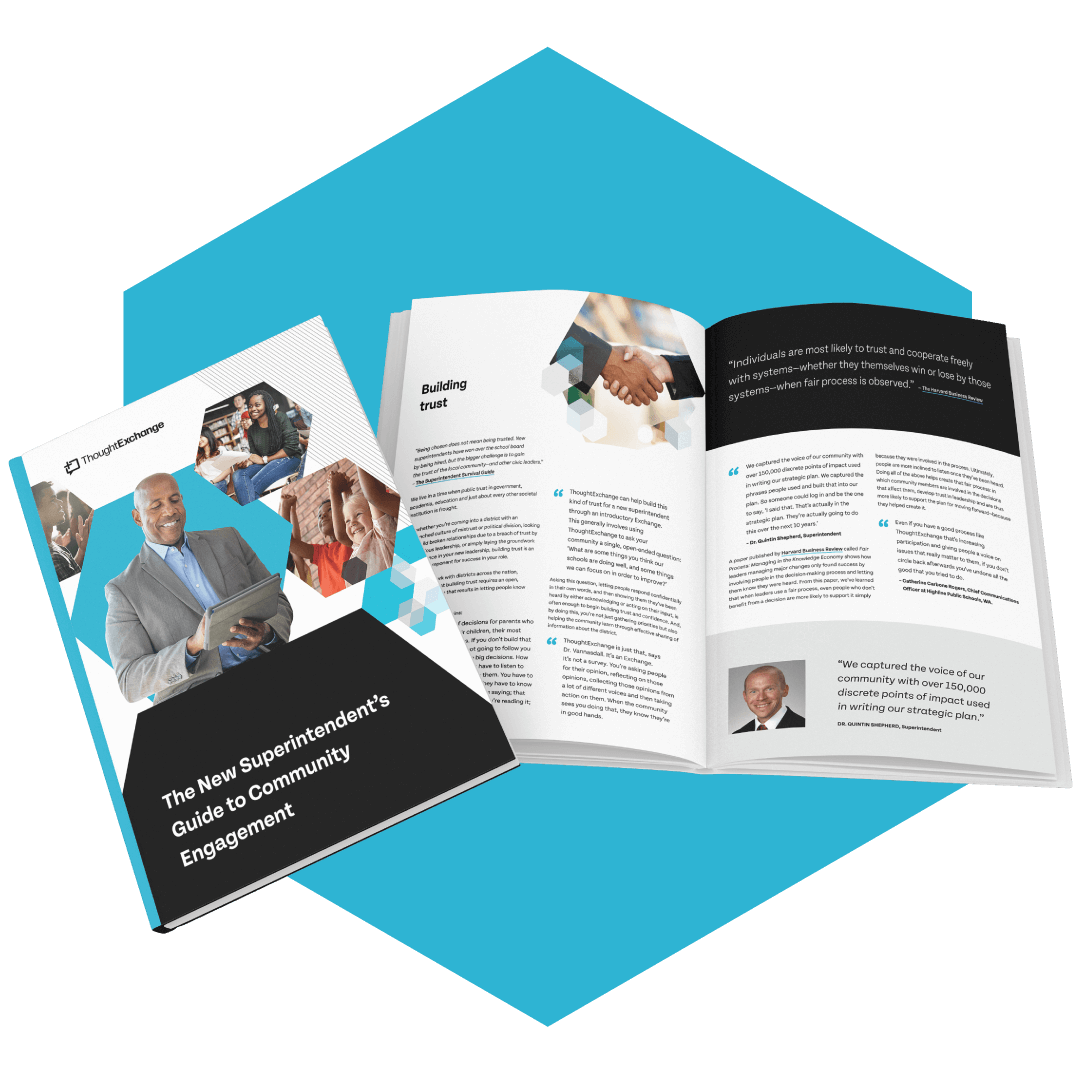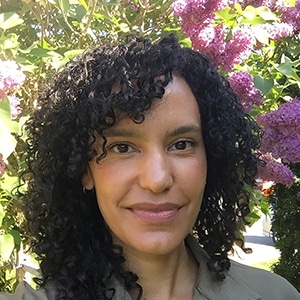5 Tips for creating an effective school strategic plan for K-12








Strategic Planning for K-12: 5 Tips for Superintendents
Effective strategic planning for K-12 is critical for achieving your district's goals. But how do you create strategic plans that work? Engage and align your educational partners—teachers, staff, students, and parents—throughout the process. And evolve your plan as needed.
ThoughtExchange can help you with your district’s strategic planning goals from concept to completion—and all steps in between. Here’s how.
In this Article
Gather community feedback
Need insights to inform your strategic direction or want to assess your strategic plan’s viability? Involve your educational partners for community feedback. Consult students, parents, and community members throughout the planning process so your strategy aligns with their perspectives.
Whether you’re setting strategy at the district, school, or department level, consulting participants will uncover unbiased insights, enhance trust, and ensure greater success with new strategic directions.
District consults community for more effective strategic plan
A school district gathered community feedback to inform their strategic priorities before planning. This enabled them to create a strategic plan that addressed the community’s most pressing concerns.
Using ThoughtExchange, they asked:
What are some important things for us to consider as we develop our new strategic priorities?
Hear what your community really thinks with an Exchange
ThoughtExchange engagement and survey platform allows superintendents to scale open-ended feedback, reducing the time and resources spent on town halls and meetings while providing insight into what people really think.
Our Exchanges prioritize qualitative data. Participants share their ideas anonymously and rate the thoughts of others based on merit, with the most supported ideas rising to the top.
Multilingual capabilities allow for simultaneous translation in 104 languages, so participants can share and read thoughts in their preferred language, ensuring a diverse, inclusive, community-wide discussion everyone can participate in.
Whether you’re bringing 10 or 10,000+ people into one Exchange, you’ll discover what’s most important to your community and inform your strategic direction.
Looking for more strategic planning in education tips? Read: Strategic Planning in Education – 3 Keys to Success
Gather internal feedback
Do you know what your staff thinks about your strategic priorities? It’s time to find out. A long-time superintendent noted that to succeed, a strategic plan must be “something everybody lives and works daily.”
Getting internal buy-in is essential for success. Inform your plan and refine your strategic objectives by asking your principals, teachers, and staff how they align with the strategies they use to fulfill their roles.
Checking in with staff throughout the planning process builds trust, support, and ownership. Gather feedback and identify knowledge gaps in the strategy before seeking broader validation.
Superintendent engages senior education leaders to inform plan
A new superintendent launched an Exchange with more than 150 senior leaders representing 50 campuses.
She asked:
As a leader, what are the most important things I need to know to support you and make this a successful year?
She was able to answer their feedback in real time and use their insights to inform her plan for the year. Checking in throughout the process will ensure her plan meets her district staff’s needs. You’ll get better data, even with large districts.
Surveys get you all the data you need in one place
Your strategic planning process may require various engagement methods to track progress. From Exchanges to surveys, we’ve got you covered.
Keep all your data in one place with surveys. Surveys allow you to efficiently gather and analyze qualitative and quantitative data to quickly and accurately inform decisions.
With a variety of question types, instant analytics, branching, secure access, and participation grouping, surveys have everything you need for fast, effective engagement. Plus, analyze thousands of open-ended and comment-box answers with ThoughtExchange’s AI Advisor tool.
Use ThoughtExchange to inform, refine, and align your strategic plans. Present the plan and gather your people’s thoughts to ensure your strategy is on track. If needed, ask for additional insights and refine your plan as needed.
Find common ground
District finds common ground in safety initiative
Brighton Central School District’s Superintendent, Dr. Kevin McGowan, understood that meaningful, transparent, two-way communication was key to his district’s safety initiative.
That’s why he used ThoughtExchange to gather insights about law enforcement in schools. An Exchange, allowed McGowan to capture marginalized voices he may have otherwise missed. It also made space for a safe, open conversation between community members with different perspectives on law enforcement in schools.
Understanding his community’s feelings of fear, anxiety, and pressure helped McGowan make better, more inclusive decisions about his school safety initiative.
Find common ground with Differences
ThoughtExchange’s Differences feature identifies common ground by revealing where participants agree and disagree in real time. Identify polarizing ideas and discover strategies everyone agrees on.
Include everyone’s insights in a collaborative discussion space, so community members feel heard. Break down silos and expose your community to the breadth of perspectives in your district. Easily find agreement between polarized groups.
Align your community on the strategy
High-performing districts are aligned, engaged, and change-ready. Districts that prioritize community alignment see increased attendance, improved student performance, stronger school reputations, and positive relationships between staff, students, and families.
Leaders in top-performing schools know that their strategic plans will likely only succeed with community support and the insights that come with community engagement.
Ensure your district is on the same page by allowing your community members to contribute to and shape your strategy. Involving your community from the start creates trust, support, ownership, buy-in and robust, supported strategic plans.
District uses ThoughtExchange to pass $110M budget
A school district faced almost 2 million dollars in unexpected expenses. At the same time, they were just about to put their proposed 2022/2023 budget to vote, asking their educational partners to approve a 2.98% increase in the tax levy and an almost $5 million increase on the previous year’s budget.
Knowing community feedback would be vital for creating a supported, strategic budget, they launched an Exchange.
They asked:
What are your priorities for the 2022-2023 Operating Budget of the Guilderland Central School District?
Staff, students, parents, and community members all shared their priorities. The Exchange data had a positive impact on their operating budget.
Find agreement with Differences
Measure performance
After you’ve launched your strategy, continue to measure its performance, evaluate, and check in with your educational partners for feedback. Run surveys or drill deeper with a series of Exchanges to assess your strategic direction and how it performs at the school and community levels. Gather insights from staff and educators to monitor progress.
Build ownership and buy-in when making key decisions. Support the decision-making process by including more perspectives and ensure greater outcome adoption. Consider what information you need to share, such as how far along you are in the decision cycle and how you intend to use the results to inform the decision.
From quick quantitative data to qualitative, in-dept discussions, ThoughtExchange’s robust platform gets you all the data you need in one place. Easily export your data as CSV or a report to share with interested parties.
Check in with your educational partners after the decision has been implemented and people have had some time to assess the impacts. Strategic planning is not a one-off process. Be ready to reassess and pivot with your community's support.
District follows up on changes
A district had implemented changes for the new school year and wanted to understand how they were affecting the community. During the first week of school, they sent an Exchange out.
They asked:
Now that we've started the new school year, what do you think is working well and what areas could be improved?
They received valuable feedback from their staff, students, and parents, informing some necessary adjustments to the new policies. The superintendent of the district has an unprecedented level of support from her community because of her willingness to ask for and act on their feedback using ThoughtExchange.
Demonstrate impact with our suite of reporting, presentation, and facilitation tools
ThoughtExchange for strategic plans that work
Be bold with your strategic plans knowing that ThoughtExchange makes gaining community engagement and buy-in easier. By accessing your community’s unbiased, critical insights, throughout the planning process, you can be confident that your plan addresses your district’s real needs.
Author’s note: This post was originally published on December 5, 2022, and has been updated for accuracy and relevance.





